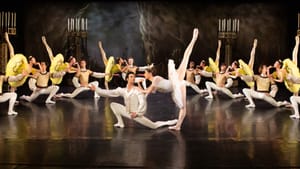Stay in the Loop
BSR publishes on a weekly schedule, with an email newsletter every Wednesday and Thursday morning. There’s no paywall, and subscribing is always free.
Dance of the rebrand
Dance lovers ask why the Pennsylvania Ballet is now the Philadelphia Ballet

I was stunned when the email hit my inbox: the Pennsylvania Ballet had changed its name to the Philadelphia Ballet and would open its season at the Performance Garage. Wait—what?
When I spoke with Pennsylvania Ballet board chair David Hoffman one year ago, he told me that he had accepted the position because “I believed that we wanted to be the best ballet you could be as opposed to shrinking into something less.” In the 2014-15 season, his first transformative action was to bring in Angel Corella as artistic director, and by 2019 the company was at peak performance. Corella was talking about the ballet’s international reputation and strategizing toward an international tour, telling me last year that “there is so much buzz” from other presenters and other countries. Spain was in the future, and China.
The pandemic put those plans on hold, but the ballet became one of the first major arts producers in the city to offer a series of previously recorded performances when it released its Front Row Festival. Then, as the Philadelphia Orchestra, Opera Philadelphia, BalletX, and other companies fought their way back to streaming new material, the Pennsylvania Ballet disappeared. At the last moment, it announced two weeks of digital access to a previously filmed Nutcracker, but didn't return with new performances for streaming until March 2021. Then the Pennsylvania Ballet disappeared entirely, into a new name.
“Tutus on the stage”
In our July 2020 conversation, Hoffman and Executive Director Shelly Power talked about using the pandemic as a time to examine the company’s brand. “You hear ‘Pennsylvania Ballet,’ you think of one thing: tutus on the stage,” Hoffman said, which seemed strange, given the company’s history as a Balanchine company. They’d been moving away from that designation for decades, though, adding contemporary works and leaning into those tutu ballets that paid the bills. The contemporary ballets had been a hard sell, but leaders anticipated that moving them from the Merriam to the Perelman Theater, a more cleanly modern space at the Kimmel Center, would turn that around.
So I figured that when Power talked about rebranding as a process of discovering “How people know us. What we look like. How we are messaging on digital,” she meant a new logo and marketing to Gen X and Millennial audiences. Instead, the company seems to be jettisoning almost 60 years of history and the international reputation it has built over time for a name that brings up multiple other options on Google, including the Philadelphia Studio Ballet and the defunct Philadelphia Civic Ballet. Their orchestra is now the Philadelphia Ballet Orchestra, not to be confused with the Philadelphia Orchestra.
A shrinking ballet?
I am a proud Philadelphian, but even to me the press release read as insular in its focus, signaling just exactly that “shrinking into something less” that Hoffman came onboard to prevent.
And opening at the Performance Garage will do nothing to dispel that impression. This venue in the Spring Garden neighborhood is a great (inexpensive) spot for smaller dance groups, but it holds an audience of about 100 in the kind of chairs you find in hotel conference rooms. It’s a really strange choice for the city’s flagship ballet company to open its season. BalletX, by contrast, performed its July series at the Mann, with an audience of 900 on opening night, and has scheduled its September series at the Suzanne Roberts Theatre.
Comment on the company’s page has been mixed, with some happy about the name change and some just enjoying the pictures of the dancers. Others shared their confusion and concern. One commenter wondered if this was the ballet’s second company, and another reminded us of the Philadelphia Civic Ballet. Yet another said, “I thought that perhaps the Pa. Ballet became insolvent and this was a new company.”
It seemed a good question, so I asked. According to the company’s public relations firm, “the name change has no bearing on the company's finances.” Which brings us back to that discussion earlier in the pandemic. A member of the board provided the rebranding firm’s services for free. This does not appear to be their best work. The new name neither celebrates the company’s international reputation nor signals an innovative new direction. Rather, attaching the new name to the announcement that they are opening their season at the Performance Garage sends a message of lowered expectations.
If it had to rebrand…
If the company had to rebrand this way, it would have made more sense to open the season at the Perelman Theater. In that sleekly modern space, the ballet leaders could have spun slapping the city’s name on the company as innovative and cool. Or, if the space would not yet have reopened, they could have danced at the Performance Garage (sorry, still scratching my head over that) and announced the name change when they came back to the Academy of Music, which is, at least, the historic home of the company’s money-making tutu ballets. I don’t know what the Philadelphia Ballet is thinking.
Image description: A scene from the Pennsylvania Ballet’s Raymonda Variations. One couple in the foreground, wearing white, are surrounded by a ring of eight couples, wearing yellow. They’re all in identical poses, with the men kneeling and the women with one leg extended.
Sign up for our newsletter
All of the week's new articles, all in one place. Sign up for the free weekly BSR newsletters, and don't miss a conversation.

 Camille Bacon-Smith
Camille Bacon-Smith